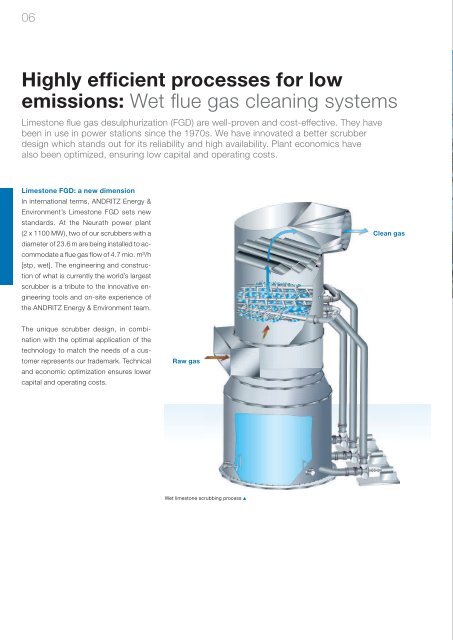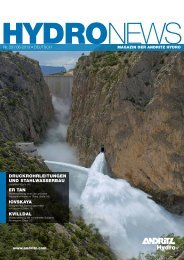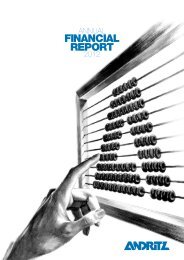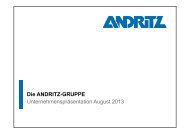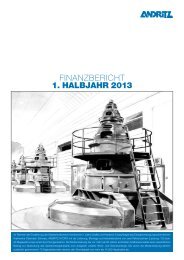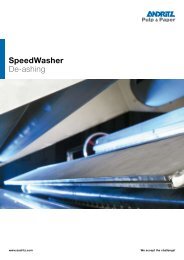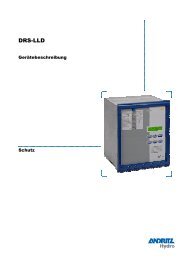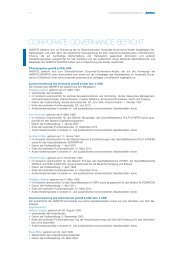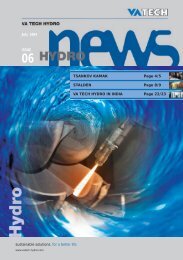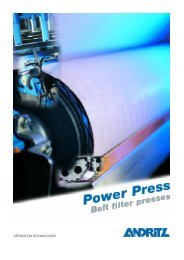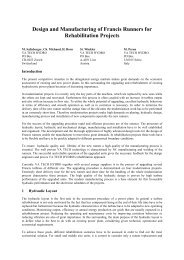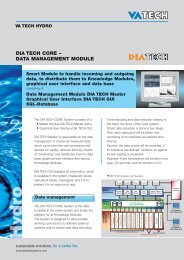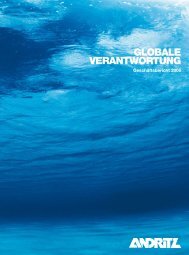You also want an ePaper? Increase the reach of your titles
YUMPU automatically turns print PDFs into web optimized ePapers that Google loves.
06 07<br />
Highly effi cient processes for low<br />
emissions: Wet fl ue gas cleaning systems<br />
Limestone fl ue gas desulphurization (FGD) are well-proven and cost-effective. They have<br />
been in use in power stations since the 1970s. We have innovated a better scrubber<br />
design which stands out for its reliability and high availability. Plant economics have<br />
also been optimized, ensuring low capital and operating costs.<br />
Limestone FGD: a new dimension<br />
In international terms, ANDRITZ Energy &<br />
Environment’s Limestone FGD sets new<br />
standards. At the Neurath power plant<br />
(2 x 1100 MW), two of our scrubbers with a<br />
diameter of 23.6 m are being installed to accommodate<br />
a flue gas flow of 4.7 mio. m³/h<br />
[stp, wet]. The engineering and construction<br />
of what is currently the world’s largest<br />
scrubber is a tribute to the innovative engineering<br />
tools and on-site experience of<br />
the ANDRITZ Energy & Environment team.<br />
The unique scrubber design, in combination<br />
with the optimal application of the<br />
technology to match the needs of a customer<br />
represents our trademark. Technical<br />
and economic optimization ensures lower<br />
capital and operating costs.<br />
Raw gas<br />
Wet limestone scrubbing process<br />
Clean gas<br />
Limestone FGD: advanced<br />
scrubber design<br />
The nucleus of our design is the scrubber,<br />
which is an open spraying tower that has<br />
been enhanced in recent years using computerized<br />
simulation techniques. We have been<br />
conducting intensive development work in<br />
this fi eld since 1995 and today enjoy a leading<br />
position which not only allows us to simulate<br />
fl ow and temperature profi les, but also to calculate<br />
the distribution of SO concentrations<br />
2<br />
in the scrubber.<br />
During comparisons of simulator data with actual<br />
plant measurements, the fl ow and temperature<br />
profi les have verifi ed our design parameters.<br />
The result is a scrubber that is characterized<br />
by minimum dimensions, adaptable<br />
scrubber entry and exit geometry, and the optimum<br />
layout of the spray nozzles and spray<br />
banks. This results in a uniform SO profi le in<br />
2<br />
combination with the highest possible superfi<br />
cial velocity in the scrubber – removing the<br />
most pollutants and utilizing the least power.<br />
Scrubber, Neurath, Germany<br />
The scrubber also benefi ts from the use of the<br />
latest materials and construction methods.<br />
GRP absorbers and reinforced concrete absorbers<br />
with polypropylene linings are used in<br />
addition to the proven steel absorbers with a<br />
variety of inner linings or stainless steel.<br />
Ruien, Belgium<br />
Key features<br />
Outstanding for all fuels (lignite, hard<br />
coal, oil, biomass, waste)<br />
SO removal > 99%<br />
2<br />
Maximum HCl and HF removal levels<br />
Gypsum as a saleable end product<br />
Flue gas volume flows of up to<br />
5,000,000 m3 /h [stp, wet] per<br />
scrubber<br />
Limestone as a favorably priced<br />
absorption agent<br />
Low operating costs and power<br />
consumption<br />
Open spray tower, low pressure loss<br />
Options for materials of construction<br />
(high alloy, carbon steel with rubber<br />
lining, concrete with PP-lining, glass<br />
fiber reinforced plastics)


